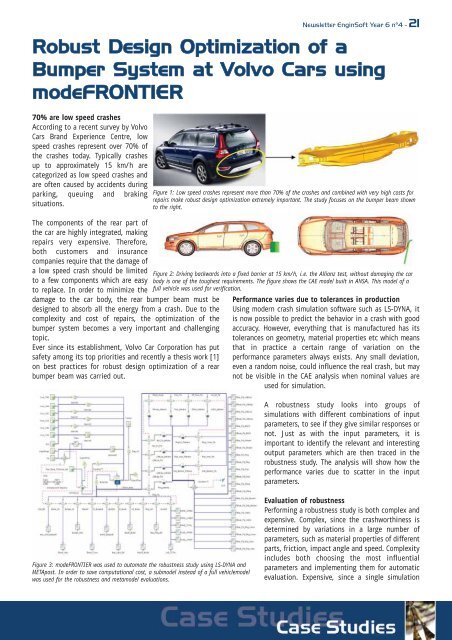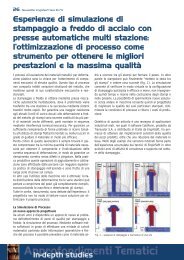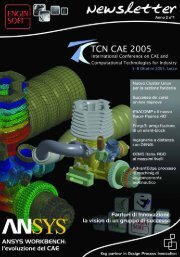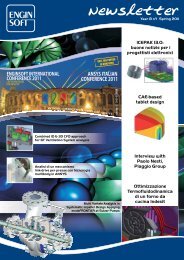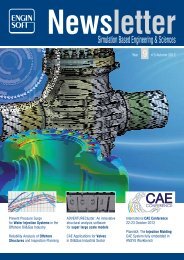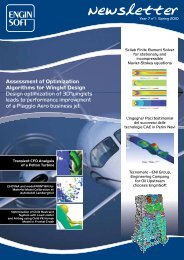software training courses 2010 corsi di addestramento ... - EnginSoft
software training courses 2010 corsi di addestramento ... - EnginSoft
software training courses 2010 corsi di addestramento ... - EnginSoft
You also want an ePaper? Increase the reach of your titles
YUMPU automatically turns print PDFs into web optimized ePapers that Google loves.
Newsletter <strong>EnginSoft</strong> Year 6 n°4 - 21<br />
Robust Design Optimization of a<br />
Bumper System at Volvo Cars using<br />
modeFRONTIER<br />
70% are low speed crashes<br />
Accor<strong>di</strong>ng to a recent survey by Volvo<br />
Cars Brand Experience Centre, low<br />
speed crashes represent over 70% of<br />
the crashes today. Typically crashes<br />
up to approximately 15 km/h are<br />
categorized as low speed crashes and<br />
are often caused by accidents during<br />
parking, queuing and braking<br />
situations.<br />
The components of the rear part of<br />
the car are highly integrated, making<br />
repairs very expensive. Therefore,<br />
both customers and insurance<br />
companies require that the damage of<br />
a low speed crash should be limited<br />
to a few components which are easy<br />
to replace. In order to minimize the<br />
damage to the car body, the rear bumper beam must be<br />
designed to absorb all the energy from a crash. Due to the<br />
complexity and cost of repairs, the optimization of the<br />
bumper system becomes a very important and challenging<br />
topic.<br />
Ever since its establishment, Volvo Car Corporation has put<br />
safety among its top priorities and recently a thesis work [1]<br />
on best practices for robust design optimization of a rear<br />
bumper beam was carried out.<br />
Figure 3: modeFRONTIER was used to automate the robustness study using LS-DYNA and<br />
METApost. In order to save computational cost, a submodel instead of a full vehiclemodel<br />
was used for the robustness and metamodel evaluations.<br />
Figure 1: Low speed crashes represent more than 70% of the crashes and combined with very high costs for<br />
repairs make robust design optimization extremely important. The study focuses on the bumper beam shown<br />
to the right.<br />
Figure 2: Driving backwards into a fixed barrier at 15 km/h, i.e. the Allianz test, without damaging the car<br />
body is one of the toughest requirements. The figure shows the CAE model built in ANSA. This model of a<br />
full vehicle was used for verification.<br />
Performance varies due to tolerances in production<br />
Using modern crash simulation <strong>software</strong> such as LS-DYNA, it<br />
is now possible to pre<strong>di</strong>ct the behavior in a crash with good<br />
accuracy. However, everything that is manufactured has its<br />
tolerances on geometry, material properties etc which means<br />
that in practice a certain range of variation on the<br />
performance parameters always exists. Any small deviation,<br />
even a random noise, could influence the real crash, but may<br />
not be visible in the CAE analysis when nominal values are<br />
used for simulation.<br />
A robustness study looks into groups of<br />
simulations with <strong>di</strong>fferent combinations of input<br />
parameters, to see if they give similar responses or<br />
not. Just as with the input parameters, it is<br />
important to identify the relevant and interesting<br />
output parameters which are then traced in the<br />
robustness study. The analysis will show how the<br />
performance varies due to scatter in the input<br />
parameters.<br />
Evaluation of robustness<br />
Performing a robustness study is both complex and<br />
expensive. Complex, since the crashworthiness is<br />
determined by variations in a large number of<br />
parameters, such as material properties of <strong>di</strong>fferent<br />
parts, friction, impact angle and speed. Complexity<br />
includes both choosing the most influential<br />
parameters and implementing them for automatic<br />
evaluation. Expensive, since a single simulation


